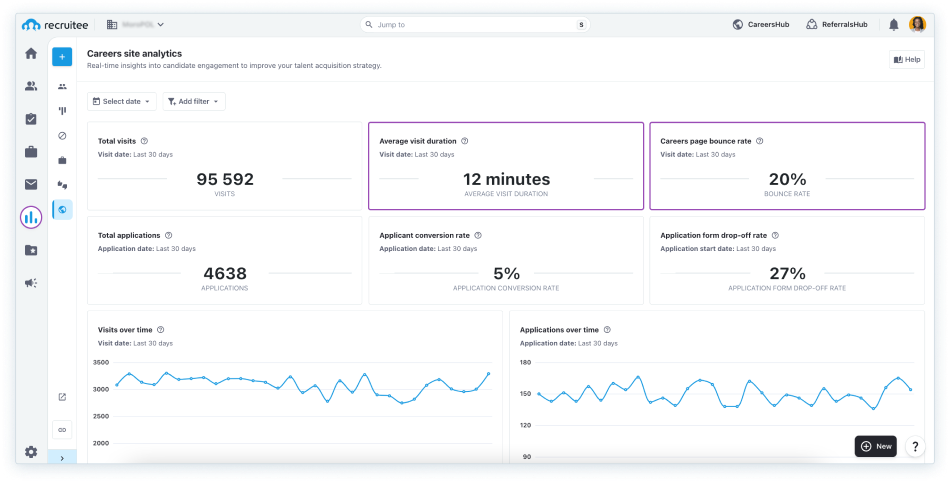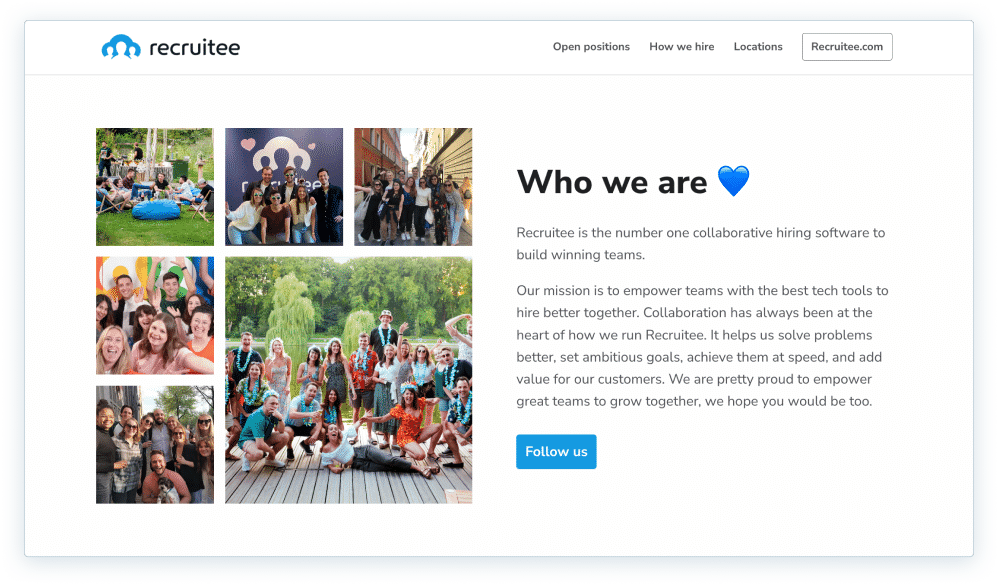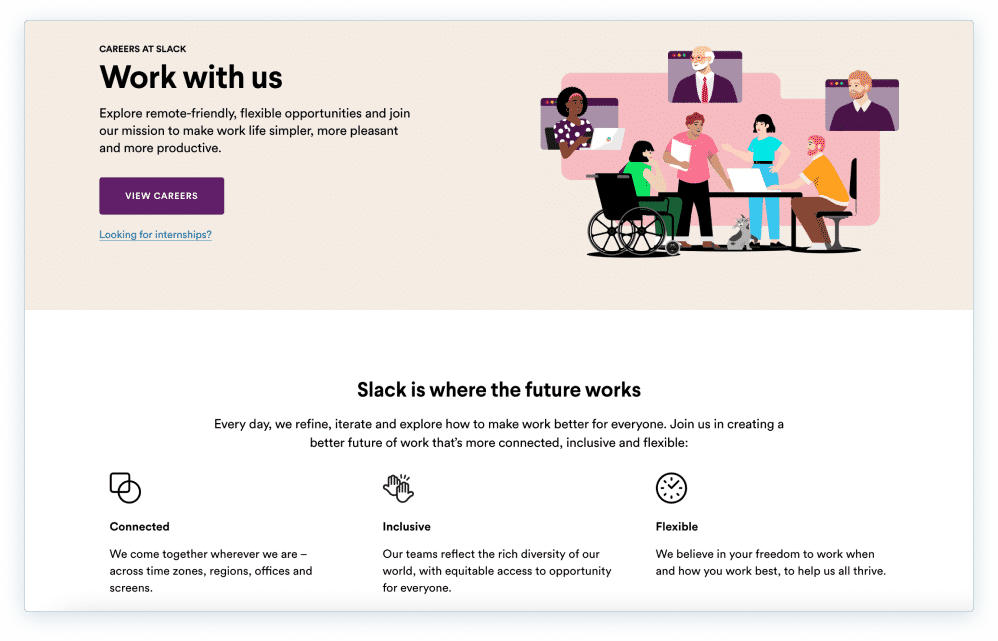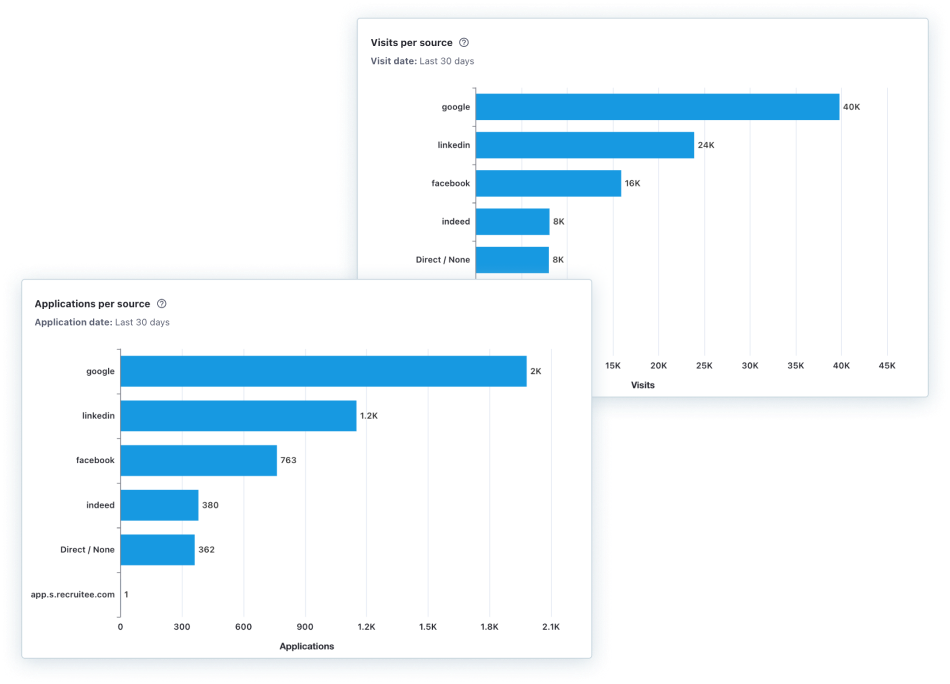Job seekers are checking you out big time. Your careers site is a central part of the candidate’s journey, and often the first touchpoint candidates have with your company before applying.
It’s where candidates can view your job openings and find the content they need to make an informed decision about their fit at your company. They’re looking to learn more about who you are, your values, and what it’s like to work there.
Did you know:
Did you know:
Did you know that 60% of all Recruitee customers’ candidates come through their careers site?
There’s no doubt that a careers site can make or break whether or not candidates eventually hit the “Apply” button.
Optimizing your careers site is an excellent place to start if you’re having trouble getting enough candidates to apply to your open jobs or attracting top talent.
In this guide, we’ll go over tips and best practices you can reference to optimize your careers site for candidate conversion with the help of Recruitee.
Introducing Recruitee’s Careers site analytics
Nowadays, it’s expected of recruiters to think and act like marketers. So we created a Careers site analytics tool you can use alongside our advanced CareersHub to make data-driven decisions, spend your budget wisely, and find the best talent faster.
It allows you to track trends in your careers site traffic, discover which candidate sources are the most effective, and how many visitors convert into applicants.
Plus, it’s easy to use and data-privacy-friendly, eliminating the need for complex tools such as Google Analytics.
Why Careers site analytics?
Do you ever ask yourself:
- How do I get more candidates?
- Where are all the high-quality candidates?
- Why is my careers site not getting many visits?
- How can I increase the number of applications for a job opening?
If you answered “yes” to any of these questions, you’ve come to the right place. We’ll soon dive into how you can track the performance of your careers site and use these insights to enhance your hiring and employer branding efforts.
But before we do that, let’s discuss why recruiters and HR professionals should care about search engine optimization (SEO).
SEO is the practice of improving a website’s rankings in the organic section of a search engine’s results. Simply put, it’s about aiming to please search engines such as Google so your careers site and job postings rank higher.
The competition is tough: Google processes more than 300 million job-related searches monthly.
SEO is one of the ways you can try to get traffic to your careers site without paying for it. You do this by optimizing your website in a few different ways.
It’s critical to investigate what’s happening on your careers site — how much traffic it gets, where candidates are coming from, which job boards you should invest in, and more.
Tracking careers site metrics and assessing your site’s performance will allow you to adapt your strategies where needed.
Ultimately, it will help you to:
- Identify your candidates’ journey before applying.
- Determine which candidate sources and job boards work best so you’ll know where to invest your resources.
- Achieve a faster and cheaper time-to-hire.
- Better showcase your employer brand and company culture.
- Add more quality candidates to your hiring funnel.
- Improve the overall candidate journey.
Here are some essential metrics you can track to measure your efforts and optimize your careers site, just like a marketer would:
Which metrics can you track with Recruitee’s Careers site analytics?
We can track the performance of your careers site with the following metrics:
- Total visits and average visit duration
- Careers page bounce rate
- Applicant conversion rate
- Application form drop-off rate
- Most visited jobs and more.
Useful tip:
Useful tip:
Make sure you use CareersHub (version 2.0) and apply SEO to your jobs and careers site. If you’re using the old version of the careers site, you’ll need to switch to this version to use Careers site analytics.
Let’s explore these metrics in more detail:
Average visit duration and careers page bounce rate
These two metrics are about the quality of visits to your careers site.

Average visit duration refers to the amount of time spent on your careers site by visitors who go to more than one page.
Careers page bounce rate refers to the percentage of visitors who visit only one page before they “bounce away” and leave your site.
Useful tip:
Useful tip:
The higher the average visit duration and the lower the bounce rate — the better.
What can you do if your average visit duration is low and your bounce rate is high?
You want visitors to stick around, especially if the goal is to make them convert (in this case, apply to your open jobs). A lengthier visit signals that your content is compelling and engaging.
These metrics vary over time, so tracking them over a month, quarter, and year is best to spot patterns in visitor behavior.
There are several reasons your careers site might have a low average visit duration and a high bounce rate, but overall, it can be a sign of a poor user experience. Let’s go through a few reasons:
Slow loading time
A careers site that takes too long to load can hurt your chances of keeping visitors’ attention and cause them to leave your site. It’s a good idea to check with your developer to discover how your site is currently performing and ensure it loads quickly on both desktop and mobile.
Poor navigation
If your careers site is not easy to navigate and intuitive for visitors, they will likely bounce. Ensuring visitors can easily find information on your site is central to user experience.
Poor design and readability
Visitors won’t spend time on a careers site that’s visually unattractive or confusing to read. Recruitee’s CareersHub lets you build a great-looking careers site and tell your brand story using predesigned sections and numerous layouts.
Lack of information
If visitors can’t find what they’re looking for on your careers site, they will also bounce away.
Applying to a new job is stressful, so make sure you guide them in the right direction and encourage them to submit their application.
The more they can learn about what it’s like to work at your company, the better. What kind of information should you give potential candidates? We dive into that next.
Applicant conversion rate
This metric shows the percentage of visits which resulted in a successfully submitted job application.
To improve your applicant conversion rate and get more high-quality candidates through the door, you can try optimizing your job postings and giving visitors an authentic look into your company.
Here are a few steps to send you on your way to getting more applications:
Write compelling job descriptions
Candidates won’t apply if they don’t resonate with your job description or if it’s missing information.
Ask yourself:
- Does your job description include essential information candidates usually look for, such as perks and benefits, salary, and job responsibilities? Here, you’ll find 20 popular job description examples.
- Does the job description resonate with the ideal target candidate? Learn more about building a candidate persona in this simple guide.
- Are you looking for a junior candidate but listed senior responsibilities (or vice versa)? It could confuse job seekers and cause them to drop off.
So how can you improve your job descriptions?
Have an intake meeting with the hiring manager about the requirements for the role and their ideal candidate. Use this information to build out the job description — the language and relevant keywords and phrases will naturally come.
Your job description should clearly explain what the job entails and help candidates to envision themselves in the role. Use short sentences, headers, and bullet points to keep it readable for your audience (this is especially important for mobile users).
Perform SEO keyword research
You want to ensure that your job posting’s title and description are optimized for search engines so candidates can easily find your open role online.
Free keyword research tools such as Google Search Console and Google Keyword Planner can help you find popular terms to target your ideal candidates through Google search. Follow the steps in this guide to choose keywords for SEO.
Avoid buzzwords and abbreviations
If you use them, take buzzwords like “ninja,” “guru,” or “superstar” out of your job description. Candidates don’t search for them! Most people will type in complete terms, such as “Customer Support Specialist,” which means a job posting that contains “Customer Support Guru” will be hard to find.
Be as descriptive as possible (“Senior Customer Support Specialist”) and avoid using abbreviations in your job titles (“Sr. Customer Support Specialist”).
Use straightforward URLs
Clear and relevant URLs do well in searches. Using Recruitee, you can create a searchable URL by typing the job title keyword. If you’re hiring a Customer Support Specialist, the URL should be customer-support-specialist.
Personalize your careers site
Give candidates a unique look into your company. Create sub-pages to showcase what you’re company is all about and inject some fun into it.
Consider adding the following information:
- Company culture and values
- Company mission and vision
- Perks and benefits
- Work setup
- Company awards
- Employees testimonials
- Team/company/office photos
- Video content.

Looking for some inspiration? We recently optimized our own careers site, and here we have listed ten well-crafted career pages to inspire and supercharge your hiring.

Application form drop-off rate
This metric shows the percentage of application forms that were started but not submitted.

A high application form drop-off rate could mean your application process is too complicated or lengthy.
If you want to keep candidates from exiting the application form when trying to apply, you need to make the process smoother and more user-friendly.
Give candidates flexibility, and don’t ask too much from them. Let them choose if they want to apply through your careers site or with their LinkedIn or Indeed profile (trust us, they’ll love it).
If you use screening questions as part of your application process, exclude any questions that are not necessary. Providing a short application form will ensure a great candidate experience.
Applications per job
With this metric, you can see which jobs get the most applications. It allows you to draw conclusions about which jobs attract candidates and which ones don’t and optimize your recruitment strategy accordingly.
Visits and applications per source
The Visits per source metric shows the number of visitors that reach your careers site and where they come from, for example, Glassdoor, LinkedIn, or organic traffic.
Under Applications per source, you can see which channels give you the highest number of candidates.

Knowing which sources give you the most conversions is essential, so you can stop investing in job boards that don’t work for you and promote your employer brand in the right places. The result? A faster and cheaper time-to-hire — the holy grail of recruitment!
Conclusion
Why bother with all of this? It can help you to identify the strengths and weaknesses of your candidates’ journey — even before they apply — and make better data-driven decisions.
Tracking these metrics with our simple-to-use tools will help you optimize your recruitment and employer branding strategy and achieve your desired results.








